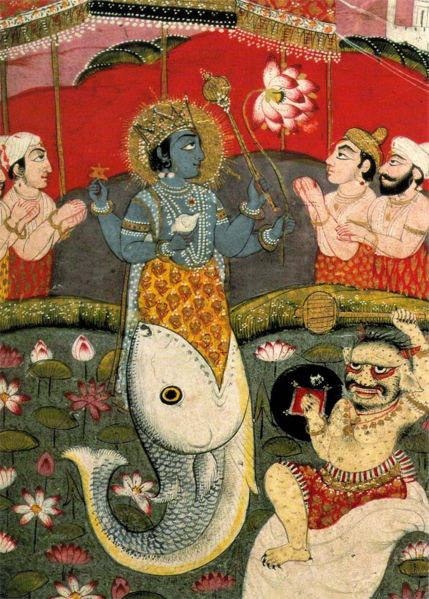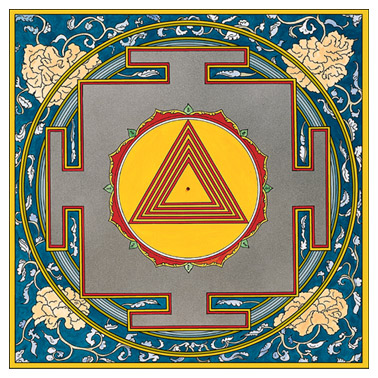
Vishnu
Vishnu is the Trimurti God - Supreme
God for the vaishnava denomination.
Man can see one thing differently - it depends on the angle from
a direction of which he comes nearer the object he wants to grasp.
Thus, we can say:
1) War between the Pandus and Kurus was only a useless killing
and I do not want such a God.
or
2) It was the war the purpose of which was to follow Dharma (justice)
where the good ones win over the bad ones.
The first incarnation
of Vishnu was "Matsya" or Fish. Matsya Purana has
more to tell.
Manu
In Hinduism, Manu is the name of the progenitor of humankind
- the first man to rule on Earth. The man saved mankind from the global
flood in an account analogous to the Biblical Noah. He was honest,
which is why he was called Satyavrata (oath
of truth).
 Many
thousands years ago, when life first appeared on our Earth, a horrible
demon intimidated antediluvian population. He prevented wise followers
of Dharma from performing their rituals and stole the Holy Vedas,
taking refuge in depths of the ocean. Lord Brahma, the Creator of
the world, came up to Lord Vishnu and asked for help. Vishnu immediately
agreed to act. He assumed the form of a fish and plunged into the
ocean. Lord Vishnu then killed the demon by ripping open his stomach
and He retrieved the Vedas from the demon's bowels.
Many
thousands years ago, when life first appeared on our Earth, a horrible
demon intimidated antediluvian population. He prevented wise followers
of Dharma from performing their rituals and stole the Holy Vedas,
taking refuge in depths of the ocean. Lord Brahma, the Creator of
the world, came up to Lord Vishnu and asked for help. Vishnu immediately
agreed to act. He assumed the form of a fish and plunged into the
ocean. Lord Vishnu then killed the demon by ripping open his stomach
and He retrieved the Vedas from the demon's bowels.
Matsya is generally shown as a four-armed figure with the
upper torso of a man and the lower of a fish. Lord
Vishnu chose Sage Satyavrata with intention to let him
prolong the creation after Gods express their wrath by imposing the
great flood on humans, which is an account analogous to the Biblical
Noah. Manu and Noah
were surely ONE person. Satyavrata was doing penance with eyes set
on the water. One day, he suddenly noticed a fish pushing its way
up on the surface to him. He first tried to help it and put it back,
but the Fish asked him not to put it back in the water in fear that
it would be eaten up by creatures bigger than it. Sage Satyavrata
agreed and took it away to his hermitage and put it into his urn.
The Fish grew big overnight until it was bigger and bigger.
The Flood
Lord Vishnu appeared in this form of Fish in Satya Yuga.
Satyavrata was very curious about how a fish could grow so big that
it needed not an urn, but a large lake. He was also too bright to
understand that it could not be a fish. He realized that it was Lord
Vishnu in the form of Fish. Satyavrata immediately bowed to the ground
and asked why God had appeared to him in this form. The Lord told
him, "Just a week from now, the waters of the world and all
oceans will rise and submerge the entire World…" - this is the
Hindu story of the Deluge - this decision sprung out of God's
determination to suspend the development of creation, as people were
incredibly bad. "At that time you will see a spacious boat approaching
you," Lord Vishnu said to Satyavrata. "Collect all the seeds,
plants and animals required for the next spell of creation and get
into the boat and await me. The SAPTHA RISHIS
(Seven Sages) will also be with you."
The second incarnation
was Kurma or Turtle.
The third was
Varaha or Boar; Vishnu killed a bad demon in this form, He saved
the Vedas from the bottom of the ocean, which He brought back up on
the Earth's surface.
The fourth incarnation was Narasingha
(often the word Narasimha is also used) - a half-man and half-lion,
a kind of Egyptian sphinx.
The fifth was
Vamana, or "dwarf incarnation",
which occurred in Treta Yuga (the second age), long before
the events described in Ramayana; Vishnu appears to king Mahabali
(some call him Maveli or Bali). Vamana was the first Avatar of Vishnu
appearing in the completely human form.
Mahabali was a king of the Indian region presently known as
Kerala (a south Indian state bordering with Tamil Nadu), who
stands behind the most popular legend - the Onam legend, which
is a festival in celebration of king Mahabali, who returns to the
state of Kerala (for a short visit only) from underground every year.
Mahabali was an Asura, but he was very religious and performed Vedic
sacrifices. He was a great devotee of Lord Vishnu. The king was wise,
judicious and generous. He brought the era of wealth during his reign.
Everybody was happy; there was no caste or class discrimination. The
rich and the poor received equal treatment. There was no crime, no
corruption. People did not even lock their doors, as there were no
thieves in the kingdom. But because he was a descendant of Diti,
who was in opposition of Aditi, the Devas did not consider him to
be safe.
Mahabali (also popularly called Maveli or Onathappan) is believed
to have ruled in South India before the Ramayana events. His empire
is believed to have extended from the Vindhyas in the north to the
far out in the south.
Asuras did not worship Vishnu. To test the King, Lord Vishnu
disguised Himself as a poor Brahmin boy
called Vamana. He came to the
Kingdom of Mahabali as a dwarf Brahmin - the Vamana Avatar.
Vishnu said he was a poor Brahmin and asked for a piece of land. The
generous King said that he could have as much land as he wanted. The
Brahmin said that he wanted only that much land that his three steps
can cover. The king was surprised to hear such a humble request, and
insisted that the boy ask for more. But the Brahmin again said the
same thing. Just as king Mahabali agreed to grant the land to the
dwarf who would mark it with his three steps, Vamana began to expand
and eventually increased himself to the size of cosmic proportions.
With his first step the Brahmin boy covered the whole Earth
and with his second step he covered the whole sky. He then
asked king Mahabali where is the space for him to keep his third step.
The king realized that he was no ordinary Brahmin. Vishnu then offered
him to go to Patala, which is a nether world. King Mahabali
accepted this boon but asked to be allowed to visit Kerala once a
year to make sure his people are doing well. Lord Vishnu agreed.
The Onam festival is celebrated mainly in the south Indian
state of Kerala; it is perhaps the only major Hindu
festival that celebrates the reign of an Asura king, although a very
good one.
 The
sixth incarnation was Parasurama
- Lord Vishnu comes as a warrior in the period of Treta
Yuga. Parasurama belongs to the group of Chiranjeevins
(Parasurama, Mahabali, Ashwatthama, Vyasa, Hanuman, Vibhishana, Kripa,
Markandeya), which are eight immortals
in Hinduism; Karna, for example, was Parasurama's pupil in the epoch
of Mahabharata.
The
sixth incarnation was Parasurama
- Lord Vishnu comes as a warrior in the period of Treta
Yuga. Parasurama belongs to the group of Chiranjeevins
(Parasurama, Mahabali, Ashwatthama, Vyasa, Hanuman, Vibhishana, Kripa,
Markandeya), which are eight immortals
in Hinduism; Karna, for example, was Parasurama's pupil in the epoch
of Mahabharata.
The seventh Vishnu's incarnation
was Rama - he killed a bad demon Ravana
who had kidnapped His consort Sita. The entire story about Rama is
written in Ramayana.
The eighth
is Krishna.
Bhagavadgita or Gita is part of the
Mahabharata. In Gita, Lord Krishna reveals His godly wisdom
to Arjuna. Just a few moments before the war of the Mahabharata
starts, Krishna and Arjuna have a deep philosophical
discussion in which Krishna reveals Himself to Arjuna as Supreme
God; He even shows him His four hands. This dialogue is
called Gita. Arjuna, a member of the Pandu family clan, is unwilling
to start the war and Krishna explains to him that any soul is actually
immortal. Finally, the war starts and ends with the Kurus being totally
defeated.
The ninth is Buddha
(according to some opinions).
And the last one is Kalki,
the coming of whom is expected at the end of Kali Yuga; Kalki will
destroy darkness on Earth and will establish justice (Dharma).
Back


